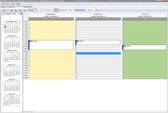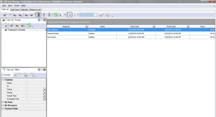|
1) What is employee scheduling and what terms it operates?
Consistent employee scheduling is a necessary practice for any organization to ensure appropriate staffing coverage making all business functions of this organization properly supported and carried out with regard to its conception of business time, labour standards, availability and qualities of its existing workforce.
The labour standards accepted in the most of modern countries state 40 hours of work during a workweek (8 hours of work everyday), and therefore employee schedules are traditionally 9 a.m. to 5 p.m., Monday through Friday. The work shift (a time period during which a person is at work) is a basic concept used for scheduling, and it comprises 8 hours for full-time workers or less for part-time workers. If employees have to work beyond of these limits (due to some reasons) this is called overtime and it should be compensated employers according to special tariff (overtime pay).
The best way to get a convenient representation of working shifts regulating staffing coverage in your company is to create a tabular layout (of working hours) that also can be called an employee shift roster or timetable, and it will consolidate and show the following matters:
- People working in your staff;
- Hours they cover daily and weekly (on-duty time);
- Positions (roles, jobs, duties, etc) they occupy;
- Their time-off hours;
2) What to consider when creating an employee schedule?
When employers compose employee scheduling templates they need to take into consideration the following essential factors:
- The company’s business time pattern (ex: Monday - Friday , 9 a.m. to 5 p.m);
- Planning horizon (how long a period in time units the schedule needs to cover);
- Workforce available (employees available in the staff, along with their skills);
- Statuses of employees (full-time or part-time workers);
- Working pattern rules for number of time units off or on (ex: five days on, two days off);
- Avoid overtimes if possible, so work shift for an employee shouldn’t be more than 8 hours;
- Avoid scheduling employees to get two or more duties at the same time, without prior feasibility consideration;
3) An example of employee schedule template:
As people say “a picture is worth a thousand words”, so let’s consider a simplified example of basic appearance that a working shift schedule has in many companies and project teams worldwide:
Monday |
8:00 AM |
9:00 AM |
10:00 AM |
11:00 AM |
Hours: |
Mike Johnson |
Manager |
Manager |
Manager |
Manager |
4 |
Teresa McGee |
Cashier |
Cashier |
Time off |
Time off |
2 |
James Brown |
Time off |
Time off |
Cashier |
Cashier |
2 |
Tom Green |
Vacation |
Vacation |
Vacation |
Vacation |
- |
Summary for the given example of timetable:
- The planning horizon here is one day (Monday) comprising 4 working hours in this day;
- This schedule has 3 active workers: the first one is “full-time”, while two others are “part-time”;
- Mike Johnson, being a full-time worker, is on-duty (as a Manager) during the whole period of 4 hours, while two others, being part-time, are on-duty (as Cashiers) for 2 hours each (they change to occupy the same workplace by turns, so this role remains working during the whole 4 hours);
- While Mike Johnson (as a full-time worker) qualifies for full set of benefits (or other forms of standard compensation), Teresa McGee and James Brown are students yet and cannot work in a full-time mode, so therefore their compensation is not so expensive to the company;
- Tom Green cannot be scheduled to take any role because he enjoys his official vacation;
The benefits of such a schedule:
- It is very easy to be created and easy-to-grasp, because it doesn’t require any advanced methods to be composed;
- It can be easily exposed to employees to provide them with an idea of how they will be assigned to their working duties, so they can get prepared beforehand;
4) General way of creating Employees Schedule:
- Get a list of all your employees and their competency range (roles they are able to take);
- Define their attendance patterns (full-time or part-time workers);
- Get a list of Roles you need to cover by the schedule (let’s say cashier, manager, etc);
- Define the planning horizon you need to observe (let’s say a week or month);
- Consider time-off requests from employees to schedule the dates when these employees will not be available to work ;
- Determine time requirements in terms of person-time units , such as worker-hours (in the given example it is 4 working hours to be covered);
- Figure out when your business has the most intensive activity (to let you know when you should schedule more employees to strengthen the staff or at least to maintain it in a full set);
- Define what Roles need to be operating during the whole day (such as Manager or Cashier) and which ones don’t need all day long attendance (let’s say IT admin);
- Draw a table like one given in the example, using a spreadsheet software (such as MS Excel) or using methods provided by some special employee scheduling software;
- Manage to fill all the hours with appropriate workers, matching their attendance patterns and their competency;
- Check the Schedule Efficiency (E) – a success measure to be calculated in a following manner:
Total employee time units required / Total employee time units scheduled
It is supposed that the closer E is to 1, the more efficient the schedule is ;
5) A way to Schedule Employees with VIP Task Manager:
VIP Task Manager is a product that stands for collaboration between managers and employees, so it allows employers creating interactive schedules to manage working shifts of employees, so let’s consider a step-by-step instruction to schedule employees in this product.
Instruments to be used:
- Resource List mode;
- Calendar mode;
- Task List mode;
- Custom task attributes;
Resource List mode actions:
- Add employees and define if they can login the system;
- Set their passwords and major details;
Calendar mode actions:
- Switch into “Day View” (make sure scale is 60 min) and turn on option “Group by Resources”;
- Select appropriate Date using “Date Navigator”;
- Add more resources to be viewed at time-grid (use “+” button);
- Use time grid to place roles (create tasks) matching your predefined timeframes (enlarge the screenshot to see example on the interface);

Task List mode actions:
- Add a Custom field “Hours” of Duration type, embedding formula $finish-$start to let you know how long a shift takes in hours;
- Customize Task List view to be convenient – discard all unwanted fields, set out the field “Hours” to be visible;
- Make sure you can see the following fields: Assigned (who is assigned to the shift), Name (for a shift’s name, such as “Cashier”, “Manager”, etc), Start date, Finish date, and Hours (enlarge the screenshot to see example on the interface);
- Additionally: You may add a custom workflow (Status field) to control the status of each shift – let’s say the following statuses can be included: Open (for planned shifts), On-Duty (for running shifts) and Closed (for already finished shifts);

|